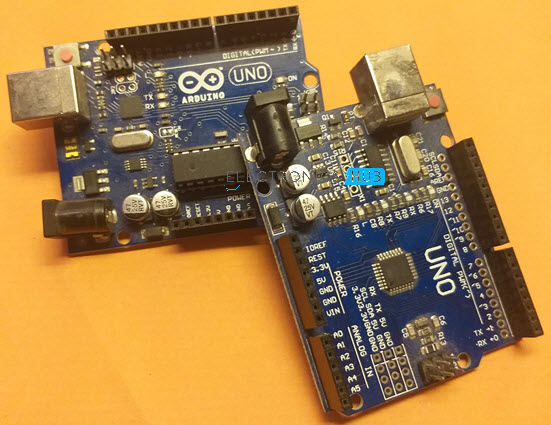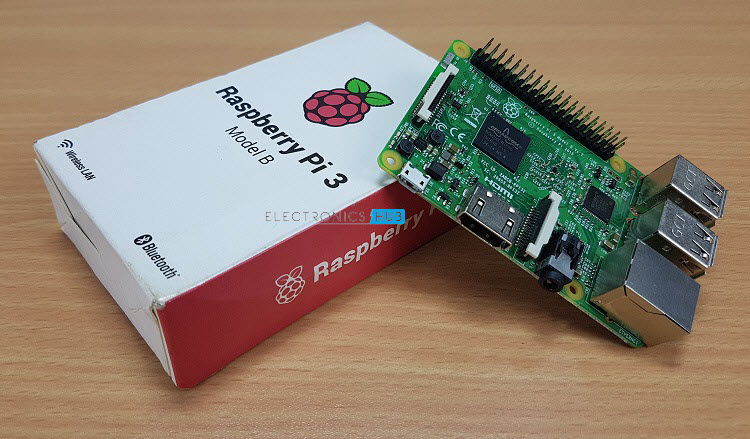Let us take a closer look at these two boards, understand the differences between Raspberry and Arduino and also build a comparison of Raspberry Pi vs Arduino in a tabular format. If you want to decide between the two, then it depends on the requirement of your project but we hope this article will helpful in understanding the differences between these two boards and helps you in selecting the right board for your next project.
Arduino
Let us start with Arduino. Arduino was developed by Massimo Banzi Et Al. in Ivrea, Italy. Arduino is a simple electronics prototyping tool with open-source hardware and software. Arduino is essentially a Microcontroller development board using which you can Blink LEDs, accept inputs from Buttons, read data from Sensors, control Motors and many other “Microcontroller” related tasks.
The most popular Arduino board is the Arduino UNO, which is based on ATmega328P Microcontroller from Atmel (now Microchip). Coming to the software side of Arduino, all Arduino boards can be programmed in C and C++ programming languages using a special software called Arduino IDE. The Arduino IDE consists of all the toolchains for editing source code, compiling and programming the Microcontroller on the Arduino board. If you have previous experience with Microcontrollers like 8051, Atmel or PIC Microcontrollers, then you probably understand the lengthy process of developing applications using these microcontrollers. If you are not familiar, then let us see the process briefly. First, you have to write the application software (the main source code) in a dedicated IDE (like Keil, Atmel Studio or PIC’s MPLAB IDE). Then you have to compile the code and generate the binary file in the form of a .hex file. Now using a special hardware called “Programmer”, you have to upload the hex file to the target microcontroller using a programmer software. Arduino simplified this process with plug-and-play style quick programming. Using a single software (the Arduino IDE), you can write the code, compile it and upload it to the Microcontroller. You also don’t need separate hardware for uploading the program. Simply plug-in the Arduino board to a Computer through USB Port, hit the upload button, et voila, the Microcontroller on Arduino board is ready to do its tasks. Another important thing about Arduino is it is open-source. This means the design files and the source code for software and libraries are freely available. You can use the hardware design files as a reference and essentially make your own Arduino board.
Raspberry Pi
The Raspberry Pi was developed by Eben Upton at the University of Cambridge in the United Kingdom with the aim of teaching and improving programming skills of students in developing countries. While Arduino is a Microcontroller based development board, the Raspberry Pi is a Microprocessor (usually an ARM Cortex A Series) based board that acts as a computer. You can connect several peripherals like a Monitor (through HDMI or AV Port), Mouse and Keyboard (through USB), connect to internet (through Ethernet or Wi-Fi), add a Camera (through the dedicated Camera Interface), just like we do to our desktop computer.
Since the entire Computer (the Processor, RAM, Storage, Graphics, Connectors, etc.) is sitting on a single Printed Circuit Board, the Raspberry Pi (and other similar boards) are called as Single Board Computers or SBC. As Raspberry Pi is essentially a full computer, it can run an Operating System. The Raspberry Pi Foundation, the organization which is responsible for designing and developing Raspberry Pi SBC, also provides a Debian based Linux Distribution called the Raspberry Pi OS (previously known as the Raspbian OS). Another important thing about Raspberry Pi is, as it is a Linux based Computer, you can develop software using several Programming Languages like C, C++, Python, Java, HTML, etc. Despite its original intentions, which is to promote programming (like Python and Scratch Programming Languages) in schools, the original Raspberry Pi SBC became extremely popular among DIY builders, hobbyists and enthusiasts for developing several applications like Robotics, Weather Stations, Camera based security systems etc. Due to its success and popularity, the Raspberry Pi Foundation is continuously updating and releasing new versions of Raspberry Pi with the latest one being the Raspberry Pi 4 Model B. The hardware design files and the firmware of Raspberry Pi are not open-source.
Differences between Raspberry Pi and Arduino
Both Arduino and Raspberry Pi are good teaching tools for students, beginners and hobbyists. Let us see some of the differences between Raspberry Pi and Arduino.
The main difference between them is: Arduino is microcontroller board, while Raspberry Pi is a microprocessor based mini computer (SBC). The Microcontroller on the Arduino board contains the CPU, RAM and ROM. All the additional hardware on Arduino Board is for power supply, programming and IO Connectivity. Raspberry Pi SBC has all features of a computer with a processor, memory, storage, graphics driver, connectors on the board. Raspberry Pi needs an Operating System to run. Arduino doesn’t need any operating system. All you need is a binary of the compiled source code. Raspberry Pi comes with a fully functional operating system called Raspberry Pi OS (previously known as Raspbian OS). Although Pi can use different operating systems, Linux is preferred by Raspberry Pi Foundation. You can install Android, if you want. Arduino does not have any operating system. You just need a firmware instructing the Microcontroller what task to do. The clock speed of Arduino is 16 MHz while the clock speed of Raspberry Pi is around 1.2 GHz. Raspberry Pi is good for developing software applications using Python, while Arduino is good for interfacing Sensors and controlling LEDs and Motors. This doesn’t mean we cannot connect sensors and LEDs to Raspberry Pi. To encourage learning programming by controlling hardware, the Raspberry Pi consists of a 40-pin GPIO, through which you can connect different electronic components like LEDs, Buttons, Sensors, Motors etc. On Arduino, the GPIO is called as Digital IO (for digital Input and Output) and Analog IN (for Analog Input). Using Arduino Shields, which plug into the Arduino Pin headers, you can add a dedicated feature or functionality like a Motor Driver, Ethernet Connection, SD Card Reader, Wi-Fi, Touchscreens, cameras etc. to Arduino. While Raspberry Pi is a self-contained board, you can add external hardware like Touchscreen, GPS, RGB panels etc. to Raspberry Pi. The Raspberry Pi Hardware Attached on Top or HAT Expansion Boards are inspired by Arduino Shields, using which you can add additional functionality to Raspberry Pi. They are connected to the GPIO Pins. The power requirements of Raspberry Pi and Arduino are completely different. Even though they both are powered by USB (micro-USB or USB Type C for Raspberry Pi and USB Type B for Arduino), Raspberry Pi needs more more current than Arduino. So, you need a power adapter for Raspberry Pi but you can power Arduino from the USB port of a Computer. Power interruption for Raspberry Pi may cause damage to the hardware, software or applications. In case of Arduino, if there is any power cut it again restarts. So, Raspberry Pi must be properly shutdown before disconnecting power. Arduino uses Arduino IDE for developing the code. While Raspberry Pi can use Python IDLE, Eclipse IDE or any other IDE that is supported by Linux. You can also program using the terminal itself with any text editor like Vim. Using the open-source hardware and software files of Arduino, you can essentially create your own Arduino board. This is not possible with Raspberry Pi as it is not open-source. The cost of original Arduino UNO is $23 but there are several clones of Arduino which are available for less than $4. Coming to Raspberry Pi, the original Raspberry Pi SBC was around $35, but the latest Raspberry Pi 4 Model B is available in different price points ($35, $55 or $75) depending on the memory configuration.
Comparison of Raspberry Pi vs Arduino
Let us now see the comparison of Raspberry Pi vs Arduino in a tabular form.
How to decide between Raspberry Pi and Arduino?
So, to decide between the two, first you should know what you want to do in your project.
From above discussion, we can understand that Arduino is good for repetitive tasks such as opening the garage door, switching the lights on and off, reading from temperature sensors, control a motor as the user wants, etc. While Pi is good for performing multiple tasks, driving complicated robots, playing videos, connect to internet, interface cameras, etc. For example, if you want to develop an application where you want to monitor Humidity and Temperature from DHT11 Sensor and display the results on an LCD, then Arduino can be used to implement this. But if you want to monitor the Humidity and Temperature from DHT11 Sensor, send an e-mail with the results, check / compare the reading with a weather report from online and also display the results on an LCD, then Raspberry Pi is the right choice. In simple, Arduino is used for beginners projects and quick electronics prototyping while Raspberry Pi is used for and some complicated projects can be easily handled by pi.
To me this seems to be a Raspberry Pi for the Base Unit with a Arduino connected to it to run motors, while all the External Units would be just Arduino’s. Is this a correct assessment? Thanks, Doug Comment * Name * Email * Website
Δ







![]()